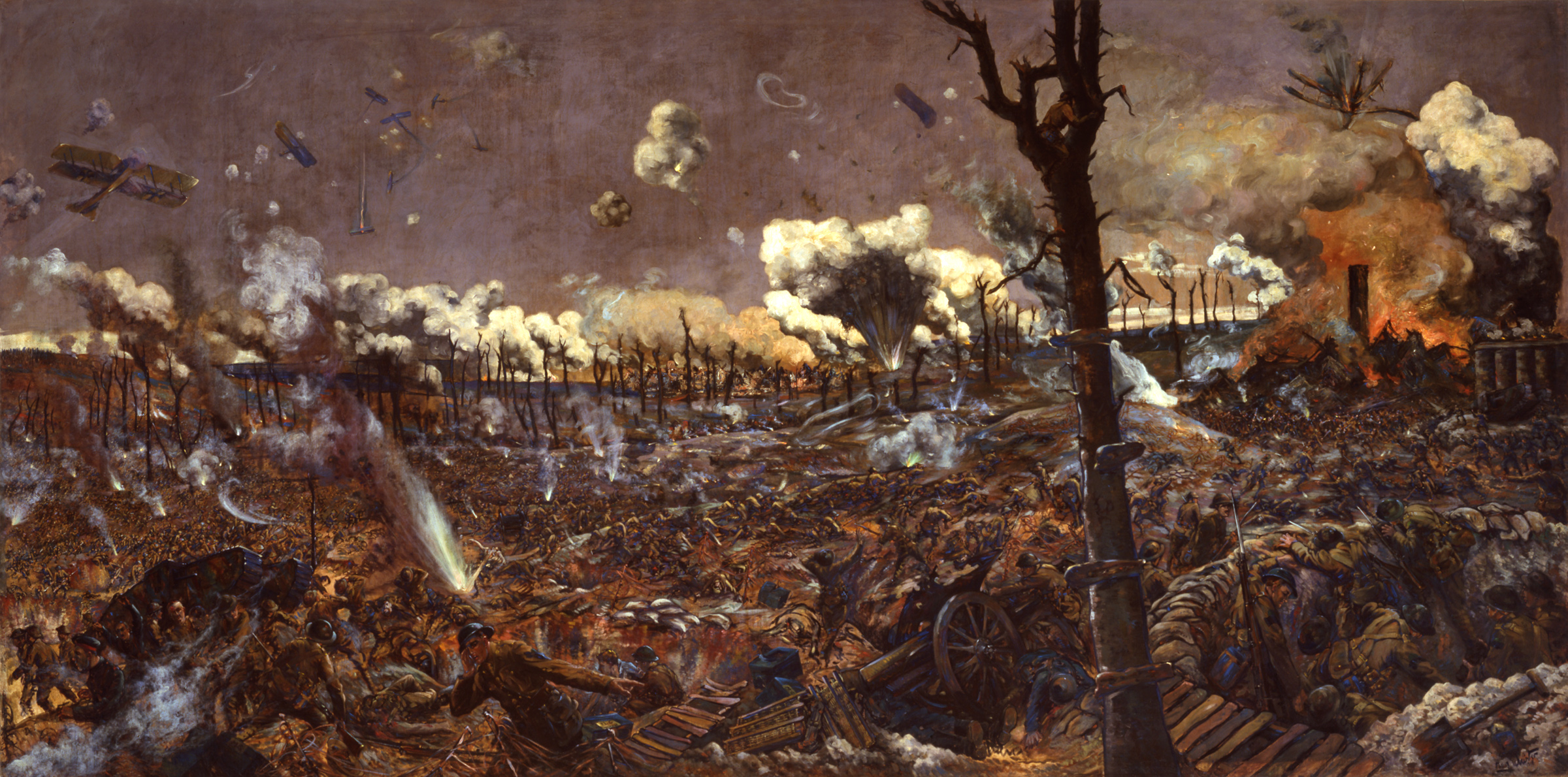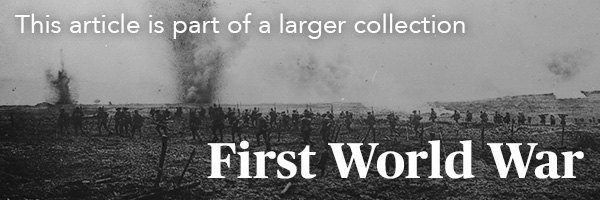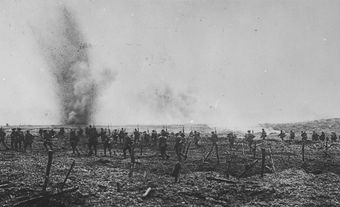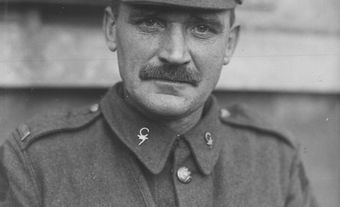|
Battle of the Somme |
|
|
Date |
1 July to 18 November 1916 |
|
Location |
Somme River valley, northern France  |
|
Participants |
British Empire (including Canada and Newfoundland), France; German Empire |
|
Casualties |
420,000 British Empire (including 24,000 Canadians and 700 Newfoundlanders) 194,000 French 440,000 Germans |

1 July 1916
After two years of stalemate in the vast trench works held by the Allied and German armies on the Western Front, the British launched a massive offensive in the Somme River valley in northern France. It was hoped the assault on a 25 km section of the front would not only break the stalemate, but relieve pressure on beleaguered French forces defending against the long-running German assault further south, at Verdun.
The Somme offensive opened with a massive artillery bombardment, which lasted five days and did little to knock out enemy troops and artillery guns. The Germans simply hid in their deep and reinforced dugouts until the barrage ended, emerging largely unscathed to face the oncoming attackers. Many British shells had also been poorly manufactured and turned out to be duds; others lacked the fuses necessary to explode on contact with the barbed wire strung across no man’s land between the opposing sides.

When British soldiers “went over the top” of their trenches in the wake of the barrage, the result was catastrophe: tens of thousands were mown down by machine-gun fire or caught up in barbed wire and then killed as they tried to reach the German lines. The British lost more than 57,000 men killed or wounded on only the first day of the battle, with little to show for their sacrifice.
Battle of Beaumont-Hamel
At the northern end of the Somme front, near the village of Beaumont-Hamel, about 800 troops of the First Newfoundland Regiment were gathered on 1 July in a support trench nicknamed St. John’s Road. They were part of a third wave of troops to attack German lines. At 9:15 a.m., the Newfoundlanders began their assault, crossing no man’s land in rehearsed lines. Out in the open, they saw that the first waves of British attackers had failed — the troops lying dead, or trapped in no man’s land, cut down by machine guns and artillery fire while trying to navigate a few narrow gaps in the barbed wire.
The Newfoundlanders pressed forward into this firestorm. Some were hit before they even reached the front of the existing British lines. Others died upon reaching the base of the Danger Tree, a prominent tree halfway between the British and German lines, where enemy bullets soon found them.
Less than 30 minutes after leaving their trench, it was all over for the Newfoundlanders. Small groups of survivors attempted in vain to fight on. Hundreds of injured men were left to fend for themselves on the battlefield through the night, where they died of their wounds or were killed by German snipers.
More than 700 soldiers of the First Newfoundland Regiment were cut down at Beaumont-Hamel. Of the regiment’s 801 members, only 68 could answer roll call by the end of the opening day.
DID YOU KNOW?
Every 1 July, while Canadians celebrate Canada Day, the people of Newfoundland and Labrador gather to also observe Memorial Day in honour of the men who fought at Beaumont-Hamel. The battlefield of Beaumont-Hamel is now a park. At its highest point, a statue of a caribou, the official emblem of the Newfoundland Regiment, looks out over the field where so many died.

Canadian Corps
Canadian forces, stationed in Belgium near the city of Ypres, were spared the first few months of fighting on the Somme. By the end of August, however, with manpower on the Somme running low, the first three divisions of the Canadian Corps (see Canadian Expeditionary Force) were relocated to the battle to help with the offensive, still grinding on under the orders of British generals.
The Canadians entered the battle on 30 August, taking part in a number of bloody attacks from September through November, supported by the first tanks used in action on the Western Front (see Armaments). The corps captured a series of strategic objectives including Courcelette, Thiepval and Ancre Heights. In November, the 4th Division of the Canadian Corps, then fighting alongside British troops, helped capture the German stronghold of Regina Trench.
DID YOU KNOW?
James Franklin, one of the first Black Canadians to enlist in the Canadian Expeditionary Force, was only a teenager when he was killed during the Battle of the Ancre Heights. He was one of the first Black Canadians (and first Black North Americans) killed in action in the First World War. Franklin enlisted in Hamilton, Ontario, and served in the 76th and 4th Battalions.

Hamilton Spectator, 10 November 1916. Courtesy of the Hamilton Public Library, Local History & Archives
Battle of Courcelette
On 15 September, Canadian soldiers launched a large-scale attack, capturing the remnants of the village of Courcelette and holding their new ground in the following days against German counterattacks (see Battle of Courcelette).
During the attack, Canadian soldiers used a new military tactic that would eventually solve the riddle of the trenches in later engagements. Known as the creeping barrage, Canadians walked behind an artillery assault that steadily advanced across German lines — keeping enemy soldiers in their dugouts — until the Canadians were on top of enemy lines and ready to fight. (Before this innovation, soldiers would wait for their army’s artillery bombardment to end before charging across no man’s land and into enemy guns.)

Tanks were also tried on the battlefield for the first time, alongside the Canadians, at Courcelette. Although slow, plodding and difficult to move, the large and imposing tanks were an effective psychological weapon against the Germans.
Courcelette was captured by the Canadian Corps on the first day of the assault, a rare Allied victory on the Somme, at the cost of several thousand Canadians casualties. Only one tank met its objectives, the rest failed because of mechanical issues, becoming stuck or being hit by shellfire.
DID YOU KNOW?
The Royal 22e Régiment (or the Van Doos — from vingt-deux, meaning 22 in French) was the only francophone infantry unit in the Canadian Expeditionary Force that was active on the front. The Van Doos’ first major attack of the First World War took place at Courcelette. The French-Canadian soldiers, commanded by Lieutenant-Colonel Thomas-Louis Tremblay, pushed back repeated German assaults and held the village while surrounded on all sides for three days and three nights (see also The “Van Doos” and the Great War).

Casualties at the Battle of the Somme
Canadian officer C. G. Barns recalled the heavy losses that were typical of the battles of the Somme offensive: “We went in about 40 strong to a platoon, 160 to a company, and if you brought out 40 or 50 men out of a company of 160, you did well. They weren’t all killed, they were wounded, but out of action…. (The Germans) had these cement redoubts stuffed with machine guns, and you’ve got to go over to get them knocked out. You had to circle and come in behind them. Well, 75 per cent of your men are knocked down before you can get in there.”

Rain and snow finally brought the Battle of the Somme to an end. After five months of fighting, the Allies had only penetrated about 13 km along a 25 km front. Allied losses were estimated at 614,000, of whom more than 24,700 were Canadians and Newfoundlanders. German losses were estimated at 440,000.

Significance
The seemingly pointless slaughter on the Somme led to questions and severe criticism of the Allied leadership, especially General Douglas Haig, commander of the British Expeditionary Force, of which both the Canadian Corps and the First Newfoundland Regiment were a part. But the offensive’s failures also sparked new thinking about military tactics — including the design of shells and the use of artillery, better planning and coordination among attacking forces on the battlefield, and the importance of allowing small groups of ordinary soldiers to exercise leadership and personal initiative during the changing fortunes of an assault.
Some of these ideas were already being experimented with among the Canadian Corps in the final months of fighting on the Somme. They would be successfully refined, contributing to the achievements of the corps in 1917 at Vimy Ridge and Passchendaele.


 Share on Facebook
Share on Facebook Share on X
Share on X Share by Email
Share by Email Share on Google Classroom
Share on Google Classroom




